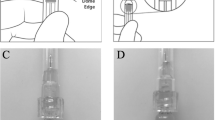Abstract
Objective
To evaluate the effect of injection quadrant switch on the intraocular pressure (IOP) change in intravitreal aflibercept or ranibizumab applications.
Methods
123 eyes of 123 patients who received intravitreal injection (IVE) into the superotemporal quadrant at least 10 times for age-related macular degeneration or diabetic macular edema have been recruited. The demographic data, lens status, IOP values (preoperative, postoperative 0th min, and postoperative 30th min), and amount of vitreous reflux (VR) following IVE have been recorded. Next IVE application was performed into the inferotemporal quadrant of the patient, which had never been injected before.
Results
The mean IOP value at postoperative 0th min was 50.24 ± 7.66 mmHg after injections into the superotemporal quadrant and was 34.85 ± 4.96 mmHg after injections into the inferotemporal quadrant. No significant difference was observed between the preoperative and postoperative 30th min-IOP values (p > 0.05), while a significant difference was found between the postoperative 0th min-IOP values among quadrants (p < 0.001). VR was significantly higher in applications into the inferotemporal quadrant than those into the superotemporal quadrant (p < 0.001).
Conclusion
One of the most principal factors affecting the postoperative short-term IOP increase is the amount of VR, and this amount decreases the IOP following an IVE. The high amount of VR produced in the quadrant where the injection was applied for the first time caused a low-level IOP, while the low amount of VR formed in the quadrant where the repeated injections were applied caused a higher IOP.
Similar content being viewed by others
References
Tolentino M (2011) Systemic and ocular safety of intravitreal anti-VEGF therapies for ocular neovascular disease. Surv Ophthalmol 56:95–113
Wong LJ, Desai RU, Jain A et al (2008) Surveillance for potential adverse events associated with the use of intravitreal bevacizumab for retinal and choroidal vascular disease. Retina 28:1151–1158
Hoang QV, Tsuang AJ, Gelman R et al (2003) Clinical predictors of sustained intraocular pressure elevation due to intravitreal anti-vascular endothelial growth factor therapy. Retina 33:179–187
Uyar E, Ulas F, Sahin S et al (2019) Major factors affecting intraocular pressure spike after intravitreal ranibizumab injection: Vitreous reflux and its amount. Eur J Ophthalmol 29:361–367
Wen JC, Reina-Torres E, Sherwood JM et al (2017) Intravitreal anti-VEGF injections reduce aqueous outflow facility in patients with neovascular age-related macular degeneration. Invest Ophthalmol Vis Sci 58:1893–1898
Goktas A, Goktas S, Atas M et al (2013) Short-term impact of intravitreal ranibizumab injection on axial ocular dimension and intraocular pressure. Cutan Ocul Toxicol 32:23–26
Cacciamani A, Oddone F, Parravano M et al (2013) Intravitreal injection of bevacizumab: changes in intraocular pressure related to ocular axial length. Jpn J Ophthalmol 57:63–67
Sharei V, Höhn F, Köhler T et al (2010) Course of intraocular pressure after intravitreal injection of 0.05 mL ranibizumab (Lucentis). Eur J Ophthalmol 20:174–179
Rodrigues EB, Meyer CH, Grumann A Jr et al (2007) Tunneled scleral incision to prevent vitreal reflux after intravitreal injection. Am J Ophthalmol 143:1035–1037
Turgut B, Demir T, Celiker U (2009) The effects of injection site on the reflux following intravitreal injections. J Clin Med Res 1:280–284
Boon CJ, Crama N, Klevering BJ et al (2008) Reflux after intravitreal injection of bevacizumab. Ophthalmology 115:1270
Knecht PB, Michels S, Sturm V et al (2008) Tunnelled versus straight intravitreal injection: intraocular pressure changes, vitreous reflux, and patient discomfort. Retina 29:1175–1181
Höhn F, Mirshahi A (2010) Impact of injection techniques on intraocular pressure (IOP) increase after intravitreal ranibizumab application. Graefes Arch Clin Exp Ophthalmol 248:1371–1375
Arikan G, Osman Saatci A, Hakan Oner F (2011) Immediate intraocular pressure rise after intravitreal injection of ranibizumab and two doses of triamcinolone acetonide. Int J Ophthalmol 4:402–405
Rodrigues EB, Grumann A Jr, Penha FM et al (2011) Effect of needle type and injection technique on pain level and vitreal reflux in intravitreal injection. J Ocul Pharmacol Ther 27:197–203
Funding
The funders had no role in the design and conduct of the study; collection, management, analysis, and interpretation of the data; preparation, review, or approval of the manuscript; and decision to submit the manuscript for publication.
Author information
Authors and Affiliations
Corresponding author
Ethics declarations
Conflict of interest
The authors declare that they have no conflict of interest.
Ethical approval
All procedures performed in studies involving human participants were in accordance with the ethical standards of the institutional research committee and with the 1964 Helsinki Declaration and its later amendments or comparable ethical standards.
Informed consent
Informed consent was obtained from all individual participants included in the study.
Additional information
Publisher's Note
Springer Nature remains neutral with regard to jurisdictional claims in published maps and institutional affiliations.
Rights and permissions
About this article
Cite this article
Altintas, M., Ulas, F., Celebi, S. et al. Effect of quadrant switch on ıntraocular pressure change in ıntravitreal aflibercept or ranibizumab ınjection applications. Int Ophthalmol 42, 2841–2846 (2022). https://doi.org/10.1007/s10792-022-02274-w
Received:
Accepted:
Published:
Issue Date:
DOI: https://doi.org/10.1007/s10792-022-02274-w




